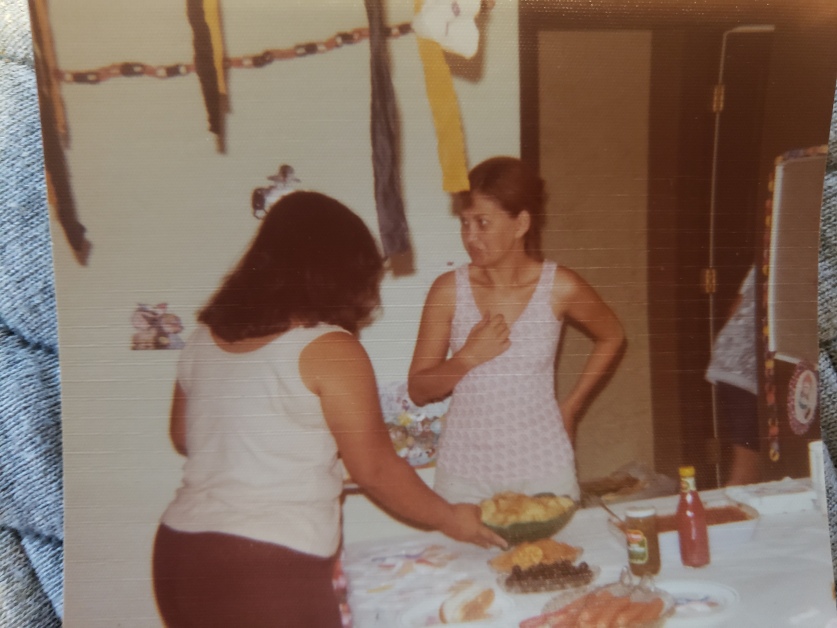As she pushes the contrast agent through the IV in my left arm, the MRI technician commends me for doing such a great job so far. The non-contrasted images are just fine, she says, and I know well enough not to ask her if she sees anything unusual. I have an appointment with my neurosurgeon right after this anyway, so I can muster the patience. And, the set with the contrast she’s just administered are the ones that will show my tumors lit up like Christmas. Those are the ones I really want to see.
The contrast sends a chill through my body; my tongue swims in metal-flavored saliva. The tumor on my sciatic nerve sends fire all down my right leg to the heel of my foot and my back aches from lying on the imaging table. I want to squirm, to adjust, to be floating in warm sea water to take the pressure off my nerves, but take deep breaths instead. MRIs mean quieting myself against the pain so I don’t move and make us have to retake any images. I’ve already been in here more than the thirty minutes they predicted and I don’t want to be in the tube for a second longer than necessary.
My arms press tight to my sides as the tech slides me back into the machine. I close my eyes. Breathe. Wonder how my enormous Polynesian father ever fit into a thing like this. My sister and I laugh they must have had to butter him. I think he would have laughed at that, too.
The Spotify channel I requested plays in the relative quiet between the grinding buzz of each new imaging, but as soon as the machine starts again there is nothing but fear of the test results and desperation to stay calm. I am not wondering if the MRI will detect tumors on my eighth cranial nerves. Right now the only answers I need are how big they are. And when will I need the surgery to remove them; a surgery that will almost certainly take away my hearing.
On the brink of panic, I retreat far into myself. Search for the most comfortable and safe time I can recall.
Grandma, where are you? I think without thinking. I reach for her arms, her waist, her red-painted toenails inside my fog of memories. She comes to me a thousand ways at once: bending over the kitchen sink while I squeeze wax-dissolving drops into her ear canal, pushing St. Joseph aspirin into my mouth as I cry out in the night, dancing hula with her sisters in front of the King Kamehameha statue before the lei draping ceremony.
The machine’s roar quiets to a low hum, and I begin to rise from the deep dark of inside. Wake, even though I haven’t actually been asleep. 1970s post-punk comes through the plastic-wrapped headphones and for the briefest of moments it’s as if Grandma is dancing to the drone of heavy electric guitars. I nearly cackle at the absurdity, stifling myself quick as I can so I don’t spoil the next image.
I reach for Grandma again and she is there in her shorty muʻumuʻu, all sparkling eyes and soft brown hands. Bringing home a brown paper bag filled with mountain apples. Sharing with me her lunch of canned sardines and day-old poi. I watch her climb the shadowy staircase of the Hui Iwa Street house, listen to the whistling breaths she takes with every step. As she gets to the top of the stairs she sings a single line from her favorite song. She pauses for breaths in the same place every time, oblivious that she is changing the way I will hear the song forever.
You’re as…lovely….as can be.
Because of Grandma, this song will sound wrong whenever anyone else sings it.
Through the headphones, the MRI tech tells me that the doctor requested additional images so please be particularly still while she focuses on my auditory nerves.
“Okay,” I reply loudly inside the tube.
I feel another chill, but this time it isn’t from contrast being pushed in through my IV. All the images of my head are important of course, but the ones being taken now are the most critical, diagnostically speaking. Bilateral vestibular schwannomas – deafening tumors on both auditory nerves – are the hallmark of NF2, the condition my father was diagnosed with in the mid-1980s. The diagnosis was clinical rather than genetic, and there have always been questions. Dad didn’t have vestibular shwannomas, as far as I knew. But there is so much about my father’s condition that nobody understood.
The doctors wanted so much to do further testing on Dad, but he refused. He said he had submitted to so many of their tests for not a whole lot of answers, and he was “done being their guinea pig.” I’ve always been angry at him for that refusal, but right this second I understand completely. The blood draws, the IVs. Being halfway naked in front of stranger after stranger and pretending any of it is okay. The isolation of being a riddle to solve, rather than a human body enduring excruciating pain.
Even the relative straightforwardness of diagnostic imaging would be too much, after awhile. The hot-and-coldness of the MRI room and nauseating metallic saliva of contrast is nothing, compared to lying perfectly still when the pain is worst of all when lying down.
How could he stand it, and how could his doctors – or his children – expect him to stand it even more? Maybe he wouldn’t have only laughed when we asked if he had to be buttered to fit into the machine. Maybe he would have also told us how close and awful and painful it was to be in there. Maybe we would have listened.
I lie in the tube, feeling like such a grade-A asshole but also reminding myself of how young I was when my dad got really sick from his condition. I had no reason to understand why it would have been so difficult for him. My father seemed like a real-life superhero, and my youthful idolization thought him capable of anything. Even when his strength began to falter, when he needed our help to walk from his office to the car, I didn’t get it. Maybe I’m only starting to now, inside this horrible tube.
I skirt dangerously close to not just tears, but uncontrollable sobbing that would certainly derail not just this imaging session but perhaps my entire day’s appointments. I don’t want to talk the technician or my neurosurgeon or even my husband about losing it during the MRI. I just want it to be over, then cry for hours in the relative safety of my own bed. I just need to make it through the next few minutes, I tell myself. I need to keep my shit together.
My heart gradually eases its frantic pounding and the heat from my cheeks begins to calm. I drift again, not quite serene, but at least not in a panic. The thrum of guitars ekes through my headphones and I concentrate on the rhythm. I fall back into a swarm of sound that does not come from the MRI machine. For a moment I listen as Ian Curtis’ voice smooths over the edges. And I go past that, into the soft darkness between awake and sleeping,
There she is again, my grandmother, wearing a white muʻumuʻu and a lei poʻo dappled with bougainvillea and baby’s breath. She is only there for a second, but it is enough to pull me back into the safety of her memory.
You’re as…lovely….as can be.
Just breathe. She comes to me now and reminds me to breathe.
The technician says we’re done with the final image and releases me from confinement. I change back into my clothes and meet my husband in the waiting room. We hurry upstairs to my Neurosurgeon’s office and get called back almost immediately. I remind myself this is probably because the imaging took so long that I am actually late for my consultation appointment. But I am waiting to talk to a Neurosurgeon about cranial nerve tumors, so it’s easy to let the what-ifs run amok.
The doctor comes in, and before he even sits down at the computer terminal he says that there are no tumors inside my skull. I am shaken by the excellent news. I mean, sure it’s great that I all of a sudden don’t have NF2, but. What does this mean for my diagnosis? For my father’s?
We look at the results of my MRI, eerie ghost-story images of my head scrolling by slice by slice. The doctor points to my auditory nerves, shows us where there would be a flash of white if a tumor was present. There is only an unremarkable darkness.
I take a breath. Then another. I try so hard to push aside questions cascading in response to this new information. To look at nerves devoid of tumors and see signs of health instead of confusion. Yes, this changes everything I have been told about my father’s condition; the one my sciatic nerve schwannoma means I’ve inherited. But it also means that as of right now, I don’t have any tumors in my skull. None.
None.
None!
I am not going to lose my hearing to vestibular schwannomas. I will be able to listen to my children bickering, my husband snoring. To every version of My Yellow Ginger Lei and feel the wrongness when they don’t pause for my grandmother’s labored breathing.
You’re as…lovely….as can be, she sings. And I hear her, loud and clear.
image: yellow ginger flowers in Hana, Hawai’i, via Wikimedia Commons




I know that this isn’t really what this post is about, but I absolutely hate the taste from the contrast. Ugh. My next MRI is coming up soon, and I am not looking forward to it.
The contrast flavor freaks me out every time.